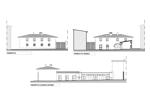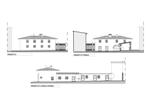|
|
|
|
|
|
Transformation of a building complex which was intended for use as executive headquaters into a residential complex
|
|
|
|
|
|
|
|
|
|
|
|
This ex-colonial building, dating back to the first half of the 1700s, underwent several construction renovations as well as changes in the intended use of the building, among which the most important is the renovation it underwent in the 1950s, in which it was transformed and utilised as the headquarters for the ENEL society. The thread of the project is to reorganise and harmonise the buildings with the surrounding area, which was completely dilapidated
|
|
|
|
|
|
|
|
|
|
|
|
The property was completely devoid of characteristics which could be traced back to its original use. As can be seen from the pictures, both the buildings and the garden were out of context within the original environment, in this case the Tuscan colonial context, the living quarters of a family. So much so that the garden had been transformed into a paved square and used as passageway and parking lot for vehicles; in the same way, the transformation of the two buildings flanking the main body, and creating an L, had completely lost their original characteristics as annexes of a colonial complex, becoming in time edifices with markedly industrial characteristics. The unifying aspect of the architectural project has purposefully taken account of the historical-architectural references, including in one single operation the entire stylistic transformation of the uncovered area
|
|
|
|
|
|
|
|
|
|
|
|
This led to its rediscovery including possible use as appendix to an interior/garden of the residential complex. In this way it would become the ideal prolongation of residential life outside the colonnade, helping contextualise the building outside the limits of construction.
|
|
|
|
|
|
|
|
|
|
|
|
The main body of the ex-colonial complex is developed on two levels in addition to the ground floor, distributed as day quarters. Its characteristics produce a sensation of wholeness between the inside and the outside, with three wide apertures
|
|
|
|
|
|
|
|
|
|
|
|
All three with glass, without anything impeding, even only visually, the physical/virtual rapport between the house and the garden. In fact, there aren't wooden gates and doors, no shutters, no blinds, no curtains. Everything is purposefully airy and luminous, making the interconnexion between what has been edified and what hasn't very natural. The kitchen was built out of the former toilets.
|
|
|
|
|
|
|
|
|
|
|
|
The living room and reading room
|
|
|
|
|
|
|
|
|
|
|
|
are linked by wide apertures which created an architectural "continuum", devoid of any physical obstacles, in which only the decorative elements communicate the intended use of the interior.
|
|
|
|
|
|
|
|
|
|
|
|
Vertical access between floors
|
|
|
|
|
|
|
|
|
|
|
|
which links the two floors and is the passage between day quarters and night quarters, is built with risers and steps in pietra serena stone, and the landing on the top floor goes on to become an L-shaped walkway, recovering the original use of one of the two windows which in the 1950’s was blocked with the insertion of a staircase. At the end of the walkway there is a library made up of five large “squares”.
|
|
|
|
|
|
|
|
|
|
|
|
The night quarters are made up of three double bedrooms
|
|
|
|
|
|
|
|
|
|
|
|
and a dressing room, while the entire access hallway has a mezzanine, which is used as an attic. The two buildings which were previously used as warehouse, with only one floor above the ground, were linked together and to the main body through internal apertures, finally creating one single edifice
|
|
|
|
|
|
|
|
|
|
|
|
inside of which we find the great TV room and a toilet, a recreation room and the large pool room
|
|
|
|
|
|
|
|
|
|
|
|
finally a service area destined for use as laundry and closet room. The dominant themes, which characterised the project and therefore also the final product, were: thermal isolation of the buildings, which was obtained through an excavation of about 80 cm along the whole ground floor, obtaining a ventilated floor which isolates from humidity and thermal imbalance, complemented by application of parquet on the entire floor area of the two levels and of the two annexed buildings; the walls as well were adjusted for thermal isolation using counterwalls made of idoneous material; bioclimatics had an important role; the installed technical artefacts had the scope of saving on energy (solar boiler), as well as with the decor, since all headboards were positioned facing north (electromagnetism), and all the electrical appliances, specially in the areas where the most time is spent (beds), were mounted following tracks that would creat a bridge reducing the effects of induced electromagnetism. Use of hardwood floors, besides making thermal isolation easier, specially at the ground floor, facilitates the electromagnetic isolation (from Hartmann nodes), reducing the power of the nanoteslas. The crawlspace allowed for effective isolation of the entire building complex, both from humidity and thermal dispersion, and at the same time, using the apertures on the perimetral walls, the natural airing and dispersion of radon - which was nevertheless already very low according to measurements done at the beginning of the renovation. In the external area, in order to gain depth and panoramic prospective, a small artificial hill was projected
|
|
|
|
|
|
|
|
|
|
|
|
|
 |
 |
|
|
|
|
|
|
|
|
|
upon which some fruit trees were planted, while a bay hedge was positioned as an internal boundary. All these details, in time, will become a natural visual barrier hiding the industrial context all around the property
|
|
|
|
|
|
|
|
|
|
|
 back back
|
|
|